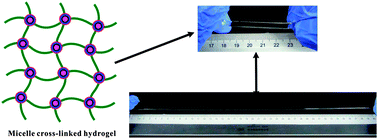In order to overcome the poor mechanical property of classic hydrogels, many methods have been explored to prepare hydrogels with excellent performance during the last few decades. In this paper, we developed a novel micellar cross-linking copolymerization method without small molecular surfactants to prepare highly stretchable and resilient hydrogels. The polymerization is based on free-radical copolymerization of water soluble acrylamide and a polymerizable macromolecular surfactant (i.e., amphiphilic polyurethane (PU) macromonomer) which can self-assemble into micelles acting as multifunctional cross-linkers. The mechanical properties, such as breaking elongation ratio, modulus and fracture toughness can be easily adjusted by varying the concentration of the polymerizable macromolecular surfactants. In addition, the mechanical energy storage efficiency (also known as resilience) is more than 96% at a strain up to 400%. The high resilience of the obtained hydrogels is due to the reversible assembly of the hydrogen-bonded hydrophobe, which contributes to the dissipation of the crack energy along the hydrogel sample, inside the micelles within the gel network.

You have access to this article
 Please wait while we load your content...
Something went wrong. Try again?
Please wait while we load your content...
Something went wrong. Try again?


 Please wait while we load your content...
Please wait while we load your content...